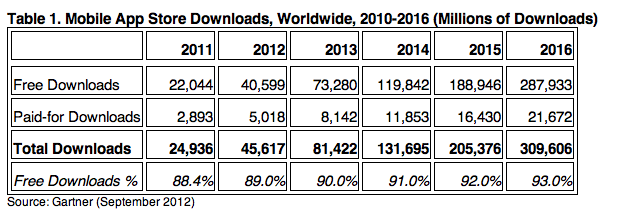The mobile app market, currently still led by app trailblazer Apple, is continuing to grow at a rapid pace: according to new research from Gartner there will be nearly 46 billion mobile app downloads made this year, nearly double the 25 billion downloads in 2011. Among those downloads, free will continue to reign supreme: 89% of those downloads worldwide will cost nothing. That is also appearing to have a knock-on effect on apps that are sold for a price: 90% of paid apps will cost less than $3.
These are pricing trends that will only become stronger. By 2016, Gartner is predicting the the mobile app market will see almost 310 billion downloads, with 93% of those free apps. These numbers point to growing opportunities for those companies that help app developers monetize their apps in other ways: not just through mobile advertising, but also through developing models for in-app purchases, subscriptions and other ways to get users to pay later for content. Indeed, in-app purchases, Gartner predicts, will drive 41% of all app revenues by 2016.

And just as free apps will continue to grow in popularity, so will the frequency of lower-cost paid apps. Apps that cost between 99 cents and$2.99 will account for 96% of all paid downloads by 2016, the analysts predict.
The rise of in-app purchases is a strong one: apps featuring IAP accounted for just 5% of all apps in 2011, accounting for only 10% of revenue. The number of apps with IAP will grow to 30% by 2016, when they will contribute 41% of revenues.
Which platform dominates? While we have seen the rise of multiple Android stores (perhaps the most popular being from Google and Amazon), as well as Microsoft making a big push on its Marketplace (now at 100,000 apps) and others like RIM also promoting its app storefront, Apple — creators of the App Store concept — will continue to be the most popular.
However, Apple’s popularity is gradually diminishing. Apple’s iOS App Store will account for more than 21 billion of the 45.6 billion mobile app downloads this year, Gartner says. That’s a rise of 74% — meaning that it’s not outpacing the growth of app downloads overall, which will have grown by 83% between 2011 and 2012.
“Apple’s market share is the largest, considering its App Store accounts for 25 percent of available apps in all stores,” writes Brian Blau, research director at Gartner.
But he also points out that growth, in fact, is being led by apps on other platforms: “The number of apps available is driven by an increasing number of stores in the market today that include platform owners, device vendors, communication service providers (CSPs) and others who want to offer core mobile app services. These stores will see their combined share of total downloads increase, but demand for apps overall will still be dominated by Apple, Google and Microsoft.”
Gartner also notes that Amazon is an example of how third-party stores also have a role to play in the game. Amazon’s Appstore and Facebook’s App Center are two that have stood out here. Gartner believes that Facebook in particular could become a “powerful competitor” to the platform stores themselves, “due to its strong brand and leading position in social networking and gaming.” That, of course, is predicated on people wanting to continue using apps with Facebook social integration in them, which is a prerequisite for apps to be offered via Facebook today.
Also noted are the rise of other independent Android stores, which have come out to cater to the proliferation of official and forked Android devices on the market. In China, that trend has been particularly strong, notes Sandy Shen, a research director at Gartner, because Google Play has a “lack of presence”:
“In China, there is a boom market of independent Android stores, due to the lack of presence of Google Play and ‘weak’ stores from [carriers]. We expect to see more new entrants to the market, aiming to deepen relationships with their customers and/or to capture some of this growth market.”
[Image: yoghaert, Flickr]
